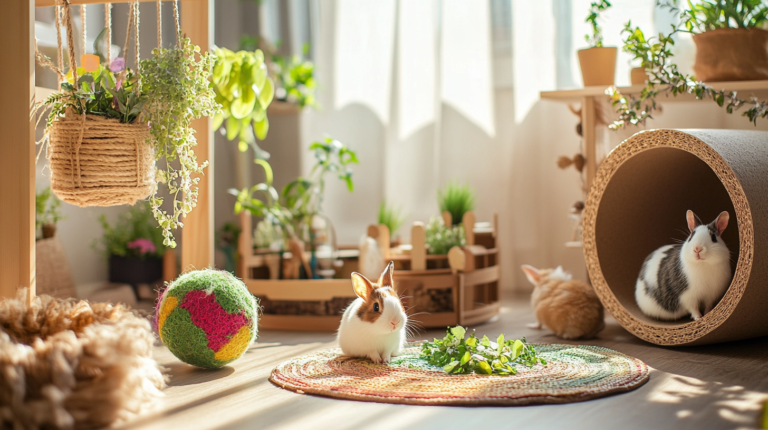Discover 10 essential everyday pet care tips that transform your pet’s health and happiness. From nutrition to senior care, master these expert strategies for optimal pet wellness.
Table of Contents
The Foundation of Responsible Pet Ownership
Bringing a pet into your home means committing to their wellbeing through consistent, thoughtful care. Whether you’re a first-time pet parent or have years of experience, mastering everyday pet care tips can significantly impact your furry friend’s health, happiness, and longevity. At BlithePet, we understand that proper pet care goes beyond the basics of food and shelter—it encompasses a holistic approach to their physical, emotional, and mental wellbeing.
According to the American Veterinary Medical Association, preventative care can extend your pet’s life by up to 25%, yet many pet owners overlook crucial aspects of daily maintenance. This comprehensive guide explores ten essential everyday pet care tips that can transform your pet care routine and strengthen the bond you share with your companion.
From nutrition and exercise to grooming and mental stimulation, these evidence-based recommendations will help you create a nurturing environment that allows your pet to thrive. Let’s dive into these practical strategies that blend convenience with optimal care.
1. Nutrition: The Cornerstone of Pet Health

Understanding Your Pet’s Nutritional Needs
Proper nutrition forms the foundation of your pet’s overall health. Dr. Sarah Martinez, DVM and animal nutritionist, explains, “What you feed your pet directly impacts their energy levels, coat quality, immune function, and even their behavior.”
When selecting food for your pet, consider these crucial factors:
- Species-specific requirements: Dogs and cats have fundamentally different dietary needs
- Age and life stage: Puppies, kittens, adults, and seniors require different nutritional profiles
- Activity level: Athletic or working animals need more calories than sedentary pets
- Health conditions: Certain medical issues may require specialized diets
Quality Over Quantity
While budget constraints are real, investing in high-quality pet food typically reduces veterinary costs over time. Premium foods generally contain:
- Higher protein content from real meat sources
- Fewer fillers and artificial ingredients
- More digestible nutrients
- Appropriate balance of vitamins and minerals
A 2022 study published in the Journal of Animal Science found that dogs fed premium diets with natural ingredients showed 30% fewer digestive issues and maintained healthier weights compared to those on economy brands.
Portion Control and Feeding Schedule
Establishing a consistent feeding schedule helps regulate your pet’s digestive system and prevents obesity—a condition affecting approximately 56% of dogs and 60% of cats in the United States, according to the Association for Pet Obesity Prevention.
For most adult pets:
- Feed measured portions 2-3 times daily
- Adjust amounts based on weight, activity level, and veterinary recommendations
- Limit treats to no more than 10% of daily caloric intake
- Ensure fresh water is always available
2. Preventative Healthcare: Beyond Veterinary Visits
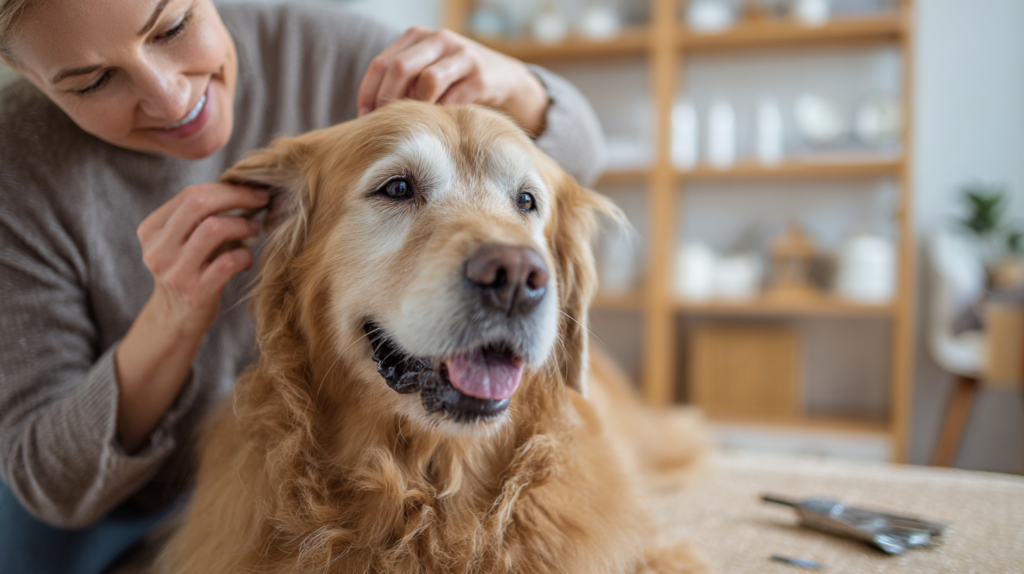
Establishing a Preventative Care Routine
Regular veterinary check-ups are essential, but what you do between visits significantly impacts your pet’s health. A comprehensive preventative care plan includes:
Vaccinations and Parasite Prevention
Keeping vaccines current protects your pet from potentially fatal diseases. The core vaccination schedule depends on your pet’s species, age, lifestyle, and geographical location.
Parasite prevention should be administered year-round, not just during warm months. According to the Companion Animal Parasite Council, year-round prevention leads to:
- 87% reduction in intestinal parasite infections
- 95% decrease in heartworm disease incidence
- Significant reduction in tick-borne illnesses
At-Home Health Monitoring
Performing regular at-home health checks helps detect problems early. Include these in your everyday pet care tips routine:
- Weekly body scans for lumps, bumps, or skin changes
- Monthly weight checks to track trends
- Dental examinations for tartar buildup or gum inflammation
- Ear inspections for redness, discharge, or odor
Record Keeping
Maintaining organized health records empowers you to participate actively in your pet’s healthcare. A comprehensive pet health journal should track:
- Vaccination dates and types
- Medication schedules and reactions
- Food transitions and any associated digestive issues
- Behavioral changes that might indicate health concerns
3. Physical Activity: Tailoring Exercise to Your Pet’s Needs

Species-Appropriate Exercise
Regular physical activity is among the most crucial everyday pet care tips, but exercise needs vary dramatically between species, breeds, and individuals.
For dogs:
- High-energy breeds like Border Collies or Labrador Retrievers typically need 1-2 hours of vigorous activity daily
- Brachycephalic breeds (flat-faced) like Bulldogs require shorter, less intense exercise sessions
- Senior dogs benefit from lower-impact activities like swimming or gentle walking
For cats:
- Indoor cats need environmental enrichment and play opportunities
- Interactive toys that simulate hunting satisfy natural instincts
- Vertical spaces encourage climbing and exploration
Benefits of Consistent Exercise
A 2023 study in Preventive Veterinary Medicine found that dogs receiving adequate daily exercise experienced:
- 42% fewer behavioral problems
- 35% reduction in obesity-related conditions
- Improved cognitive function, particularly in aging pets
Dr. James Wilson, veterinary behaviorist, notes: “Regular physical activity isn’t just about physical health—it’s essential for mental wellbeing. Many behavioral issues stem from insufficient exercise and mental stimulation.”
Incorporating Exercise Into Daily Life
Finding time for pet exercise can be challenging. Try these strategies:
- Schedule morning or evening walks as part of your daily routine
- Use puzzle feeders that require movement to access meals
- Create indoor obstacle courses during inclement weather
- Arrange playdates with compatible pets for socialization and exercise
4. Grooming: More Than Just Aesthetics
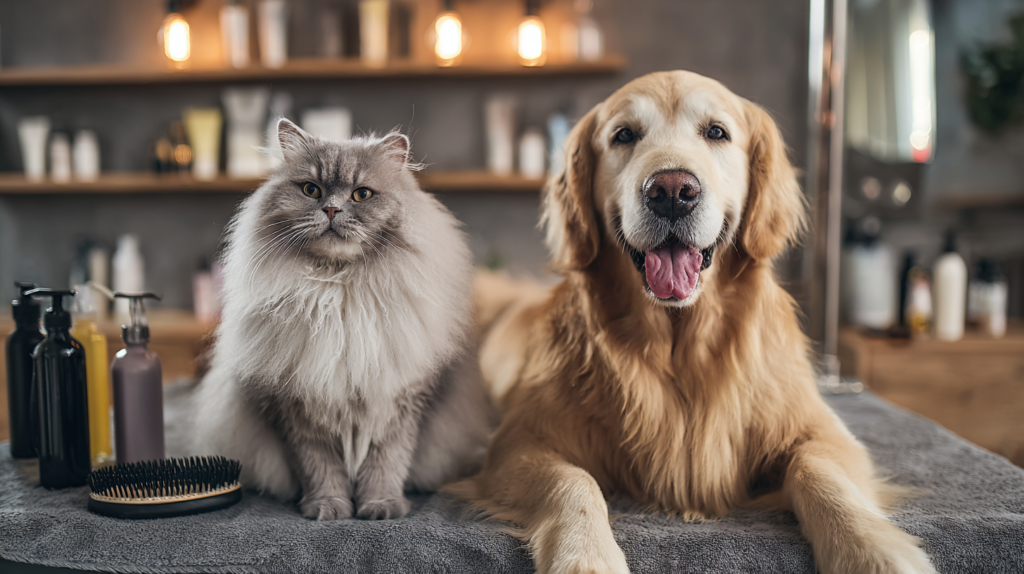
Breed-Specific Grooming Requirements
Grooming needs vary widely across different pets:
| Pet Type | Coat Type | Brushing Frequency | Bath Frequency | Professional Grooming |
| Short-haired cats | Low maintenance | 1-2 times weekly | Rarely needed | Usually unnecessary |
| Long-haired cats | High maintenance | Daily | Every 4-6 weeks | Every 4-8 weeks |
| Short-haired dogs | Low-moderate | 1-2 times weekly | Every 4-8 weeks | Every 8-12 weeks |
| Double-coated dogs | High maintenance | 2-3 times weekly | Every 6-8 weeks | Every 6-8 weeks |
| Curly-coated dogs | High maintenance | Daily | Every 4-6 weeks | Every 4-6 weeks |
Beyond Coat Care
Complete grooming extends beyond brushing and bathing:
Dental Care
Periodontal disease affects approximately 80% of dogs and 70% of cats by age three. Daily tooth brushing using pet-specific toothpaste reduces plaque by up to 85%, according to the American Veterinary Dental College.
Nail Maintenance
Overgrown nails can cause pain, affect gait, and lead to orthopedic issues. Most pets need nail trims every 3-4 weeks.
Ear Cleaning
Regular ear checks and appropriate cleaning (especially for floppy-eared breeds) prevent infections and detect early signs of problems.
Creating Positive Grooming Experiences
Many pets find grooming stressful. To create positive associations:
- Start grooming routines during puppyhood or kittenhood
- Use high-value treats and praise during sessions
- Begin with short sessions and gradually increase duration
- Invest in proper tools designed for your pet’s specific coat type
5. Mental Stimulation: Exercising the Mind

The Science of Cognitive Health
Mental stimulation is one of the most overlooked everyday pet care tips. Research published in the Journal of Veterinary Behavior demonstrates that cognitive enrichment:
- Reduces destructive behaviors by up to 52%
- Decreases anxiety-related issues
- Slows cognitive decline in senior pets
- Strengthens the human-animal bond
Enrichment Strategies for Dogs
Dogs thrive with varied mental challenges:
- Training sessions using positive reinforcement techniques
- Scent games that engage their powerful olfactory capabilities
- Puzzle toys with adjustable difficulty levels
- Rotating toy selection to maintain novelty
Enrichment Strategies for Cats
Cats benefit from activities that satisfy their natural instincts:
- Hunting simulations using interactive toys
- Bird-watching stations near windows
- Exploration opportunities through tunnels and climbing structures
- Foraging challenges that make mealtime more engaging
6. Creating Pet-Safe Environments
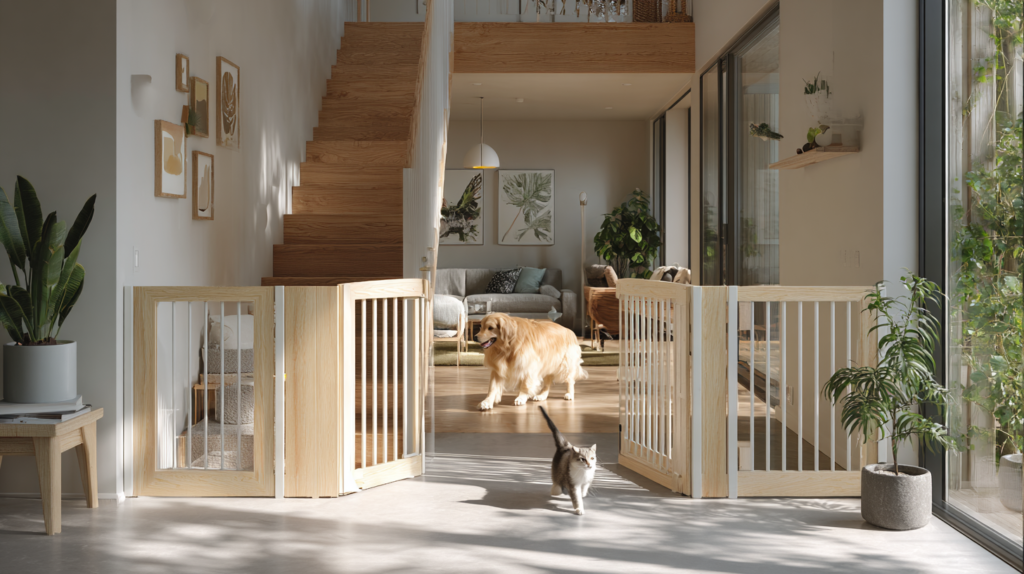
Home Safety Assessment
A comprehensive home safety audit should be part of your everyday pet care tips checklist:
Toxin Elimination
According to the ASPCA Animal Poison Control Center, household toxins account for thousands of pet emergencies annually. Common household hazards include:
- Certain houseplants (lilies, sago palms, etc.)
- Human medications
- Xylitol-containing products
- Cleaning supplies
- Antifreeze and other automotive fluids
Physical Safety
Preventing accidents requires environmental modifications:
- Secure window screens to prevent falls
- Block access to small spaces where pets might become trapped
- Cover electrical cords or use pet-safe cord protectors
- Install baby gates to restrict access to unsafe areas
Outdoor Safety Considerations
For pets with outdoor access:
- Ensure fencing is secure and appropriate for your pet’s size and capabilities
- Provide shade and shelter from weather extremes
- Use pet-safe landscaping and lawn care products
- Create identification redundancy (microchip, collar ID, and GPS tracker for escape-prone pets)
7. Socialization: Building Confident, Well-Adjusted Pets

The Critical Socialization Period
Early socialization significantly impacts your pet’s lifelong behavior. For puppies, the critical socialization window occurs between 3-14 weeks; for kittens, it’s between 2-7 weeks.
Research from the American Veterinary Society of Animal Behavior indicates that dogs who receive inadequate socialization during this period are:
- 3.5 times more likely to develop fear-based aggression
- 2.8 times more likely to exhibit excessive barking
- Significantly more prone to separation anxiety
Ongoing Socialization
Socialization shouldn’t end after puppyhood or kittenhood. Throughout your pet’s life, continue to:
- Expose them to varied environments, people, and situations
- Arrange controlled interactions with other animals
- Create positive associations with new experiences
- Respect their individual comfort levels and never force interactions
Special Consideration for Adopted Pets
For pets adopted as adults, socialization may require additional patience:
- Create gradual exposure plans tailored to their specific fears
- Use counter-conditioning techniques to change emotional responses
- Consider working with a certified animal behaviorist for severe cases
8. Training: Communication and Boundaries
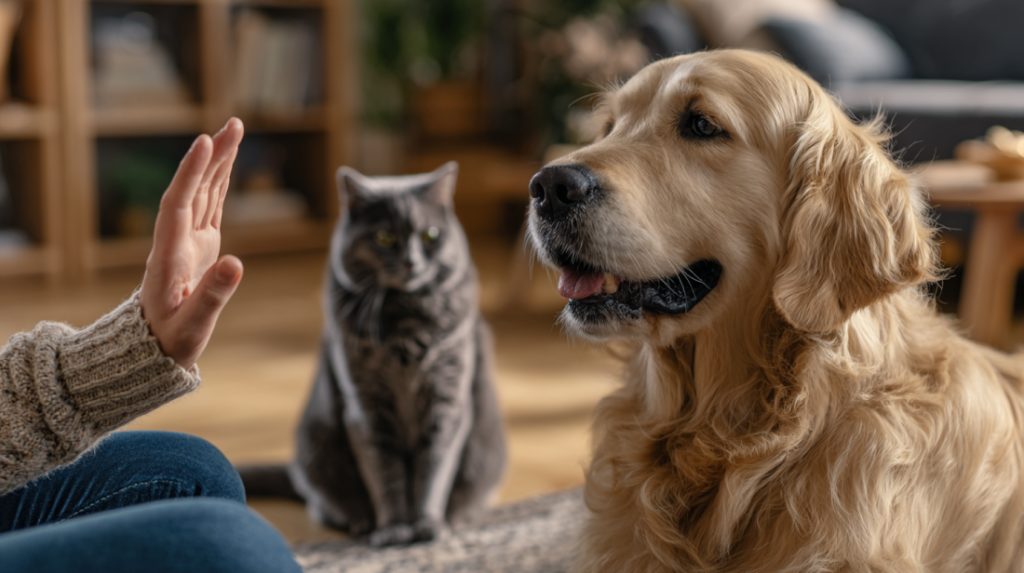
Positive Reinforcement Methods
Modern training approaches focus on rewarding desired behaviors rather than punishing unwanted ones. A meta-analysis of training methods published in the Journal of Veterinary Behavior found that positive reinforcement techniques resulted in:
- Higher success rates in behavior modification
- Stronger human-animal bonds
- Lower stress levels in both pets and owners
- Fewer behavioral side effects
Essential Commands and Behaviors
Every pet should master these fundamental skills:
- Name recognition
- Recall (coming when called)
- Polite leash walking
- Leave it/drop it commands
- Settling on command
Consistent Boundaries
Establishing clear boundaries prevents confusion:
- Create consistent household rules all family members enforce
- Define off-limits areas and furniture
- Establish mealtime protocols
- Develop greeting rituals for visitors
9. Stress Management and Emotional Wellbeing

Recognizing Signs of Stress
Pets communicate distress through subtle behavioral changes:
In dogs:
- Excessive panting or drooling
- Tucked tail or lowered body posture
- Avoidance behaviors or hiding
- Displacement behaviors like yawning or lip licking
In cats:
- Increased grooming or cessation of grooming
- Changes in litterbox habits
- Withdrawal from social interaction
- Altered eating patterns
Creating Comfort and Security
Implementing these everyday pet care tips can reduce stress:
- Establish predictable daily routines
- Provide safe retreat spaces where pets won’t be disturbed
- Use calming aids like pheromone diffusers when appropriate
- Recognize and respect individual personality traits
Managing Situational Anxiety
Common triggers like thunderstorms, fireworks, or veterinary visits can cause significant distress. Preparation strategies include:
- Desensitization training for predictable stressors
- Creating safe spaces during anxiety-inducing events
- Consulting with veterinarians about appropriate anxiety-reducing products
- Using compression garments for acute situations
10. Senior Pet Care: Adapting to Changing Needs
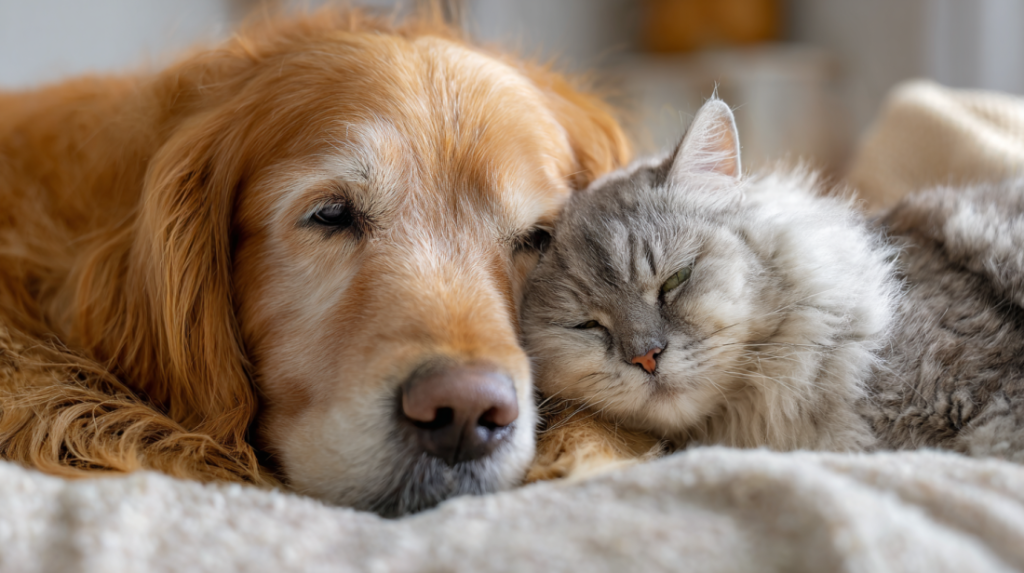
Age-Related Changes
As pets enter their golden years (generally after age 7 for most dogs and cats), their care requirements evolve:
Physical Adaptations
- Orthopedic supports like ramps or steps for furniture access
- Non-slip flooring to prevent falls
- Elevated food and water bowls for comfortable access
- Temperature-controlled resting areas
Healthcare Adjustments
- Increased veterinary visit frequency (semi-annual rather than annual)
- More comprehensive bloodwork and health screening
- Adjusted medication protocols
- Pain management strategies
Cognitive Support
Cognitive decline affects approximately 28% of dogs aged 11-12 and 68% of dogs aged 15-16. Supportive measures include:
- Brain-engaging activities appropriate for physical limitations
- Supplements specifically formulated for cognitive support
- Environmental consistency and predictable routines
- Medication options for severe cognitive dysfunction
Quality of Life Assessment
Regular quality of life evaluations help ensure your senior pet’s comfort:
- Mobility assessment (ability to rise, walk, and eliminate comfortably)
- Pain evaluation (using validated pain scales)
- Enjoyment of daily activities and interaction
- Maintenance of normal bodily functions
The Integrated Approach: How These Everyday Pet Care Tips Work Together
The most effective pet care strategy integrates all these elements into a cohesive approach. Dr. Emily Lawrence, veterinary behavior specialist, explains: “The interconnectedness of physical health, mental stimulation, and emotional wellbeing creates a foundation for truly thriving pets. When one area suffers, others inevitably follow.”
Consider how these components interact:
- Proper nutrition supports immune function, which reduces illness-related stress
- Regular exercise promotes better sleep and reduces anxiety
- Mental stimulation prevents boredom-related behavioral issues
- Consistent training facilitates safer social interactions
For more expert pet care tips and product recommendations, visit BlithePet.com — your trusted source for pet wellness.
FAQs About Everyday Pet Care
How often should I take my pet to the veterinarian?
Most healthy adult pets should see a veterinarian at least once yearly for wellness exams. Puppies, kittens, senior pets, and those with chronic conditions typically require more frequent visits—often 2-4 times annually. However, don’t wait for scheduled appointments if you notice concerning symptoms; early intervention often leads to better outcomes and reduced treatment costs.
What’s the best diet for my pet?
The ideal diet depends on your pet’s species, age, activity level, and health status. While high-quality commercial diets formulated for your pet’s life stage generally provide appropriate nutrition, some pets benefit from prescription diets for specific medical conditions. Consult your veterinarian before making significant dietary changes, especially for pets with existing health concerns.
How much exercise does my pet need daily?
Exercise requirements vary significantly by species, breed, age, and individual. Most dogs benefit from 30-60 minutes of physical activity daily, while cats typically engage in shorter, more frequent activity bursts. Senior pets and those with health limitations still need appropriate exercise but may require modifications. Observe your pet’s energy levels and adjust accordingly.
What are the signs my pet might be sick?
Early warning signs include changes in appetite, water consumption, energy levels, or elimination habits. Other indicators include unusual vocalizations, altered breathing patterns, difficulty moving, or changes in behavior. Since pets often mask illness until it’s advanced, any persistent change warrants veterinary attention.
How can I help my anxious pet?
Anxiety management requires a multi-faceted approach. Establish consistent routines, provide safe spaces, use appropriate exercise to reduce stress hormones, and consider anxiety-reducing products like pheromone diffusers. For severe cases, consult with a veterinary behaviorist who might recommend behavior modification protocols or anti-anxiety medications.
What’s the most important everyday pet care habit?
While all aspects of care are important, observation may be the most crucial habit. Spending time daily observing your pet’s normal patterns allows you to quickly identify changes that might indicate health or behavioral issues. This early detection often leads to simpler, less expensive interventions and better outcomes.
Conclusion: The Rewards of Dedicated Pet Care
Implementing these ten everyday pet care tips requires commitment and consistency, but the rewards are immeasurable. Through thoughtful, comprehensive care, you’ll not only extend your pet’s lifespan but significantly enhance their quality of life. The bond formed through attentive care deepens the connection between you and your companion, creating a relationship built on trust, understanding, and mutual respect.
Remember that pet care evolves throughout your pet’s life stages. What works for a puppy or kitten will need adjustment as they mature and eventually enter their senior years. By staying informed about best practices and remaining attentive to your pet’s changing needs, you position yourself as their best advocate and caretaker.
As responsible pet owners, we owe our companions the very best care we can provide. By incorporating these evidence-based strategies into your daily routine, you’re making a profound difference in your pet’s wellbeing—one day at a time.
Have a similar experience with your pet? Share it in the comments below!





